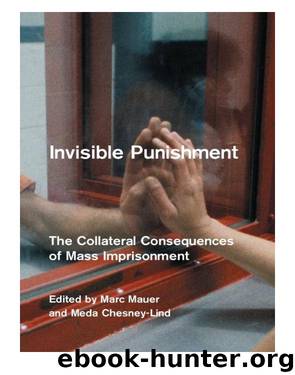Invisible Punishment by Chesney-Lind Meda Mauer Marc

Author:Chesney-Lind, Meda, Mauer, Marc
Language: eng
Format: epub
Publisher: The New Press
Published: 2011-06-02T16:00:00+00:00
A COMMENT ON THE COUNTERFACTUAL
This has been an argument that high incarceration rates destabilize community life and undermine the community forces that promote public safety. It is a subtle set of forces; less a scissor that slices social fabric and more a straw that breaks the back of social control. Each of the dynamics described above is modest in its own right; together, they add up to a significant social force. In neighborhoods that suffer large numbers of offenders removed from incarceration and then returning from prison, these small effects are so common as to become a major dynamic of community life.
The idea that incarceration becomes problematic for some communities is deeply counterintuitive in today’s public opinion climate. It seems beyond debate that any policy that removes people who do bad things leaves those who remain better off; it seems laughable to say that “incarceration causes crime.” It is important, then, to be clear about what is being argued and what is not. The line of analysis developed above is not meant to say that “incarceration causes crime.” The relationship between amounts of incarceration and levels of crime is complicated, and it would be far-fetched to claim that incarceration makes no contribution to public safety. It surely does in specific cases and under particular conditions.
The argument made here is a much more narrow one. Well-established theory and a solid body of evidence indicate that high levels of incarceration concentrated in impoverished communities has a destabilizing effect on community life, so that the most basic underpinnings of informal social control are damaged. This, in turn, reproduces the very dynamics that sustain crime.
There are, of course, plenty of families that rally in the face of a loved one being sent to prison, finding ways to strengthen child-rearing and locating substitute resources to replace the lost family member. There are plenty of families, too, that benefit from the temporary reprieve from what may well have been a damaging member of the household. Nothing in this theory of “coercive mobility” should detract from the large numbers of valiant adults and children who rise to the challenge of incarceration in their lives by finding ways to overcome the effects and not only survive, but become stronger. There are such families; there are, one can suppose, such neighborhoods. Yet, these stories are the exception rather than the rule. On average, the effects of very high levels of incarceration are destabilizing in the aggregate, and they pose a problem even the strongest families must struggle to deal with. Too many families and too many neighborhoods fail the challenge.
Download
This site does not store any files on its server. We only index and link to content provided by other sites. Please contact the content providers to delete copyright contents if any and email us, we'll remove relevant links or contents immediately.
Cecilia; Or, Memoirs of an Heiress — Volume 1 by Fanny Burney(32440)
Cecilia; Or, Memoirs of an Heiress — Volume 2 by Fanny Burney(31875)
Cecilia; Or, Memoirs of an Heiress — Volume 3 by Fanny Burney(31858)
The Great Music City by Andrea Baker(31539)
We're Going to Need More Wine by Gabrielle Union(18973)
All the Missing Girls by Megan Miranda(15598)
Pimp by Iceberg Slim(14399)
Bombshells: Glamour Girls of a Lifetime by Sullivan Steve(13979)
Talking to Strangers by Malcolm Gladwell(13233)
Norse Mythology by Gaiman Neil(13216)
Fifty Shades Freed by E L James(13163)
For the Love of Europe by Rick Steves(13116)
Mindhunter: Inside the FBI's Elite Serial Crime Unit by John E. Douglas & Mark Olshaker(9209)
Crazy Rich Asians by Kevin Kwan(9174)
The Lost Art of Listening by Michael P. Nichols(7412)
Enlightenment Now: The Case for Reason, Science, Humanism, and Progress by Steven Pinker(7242)
The Four Agreements by Don Miguel Ruiz(6641)
Bad Blood by John Carreyrou(6558)
Weapons of Math Destruction by Cathy O'Neil(6152)
